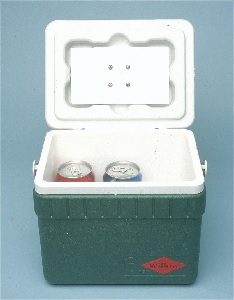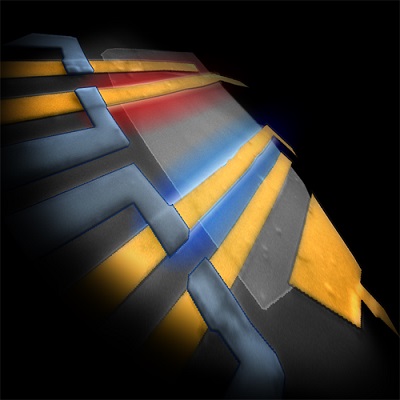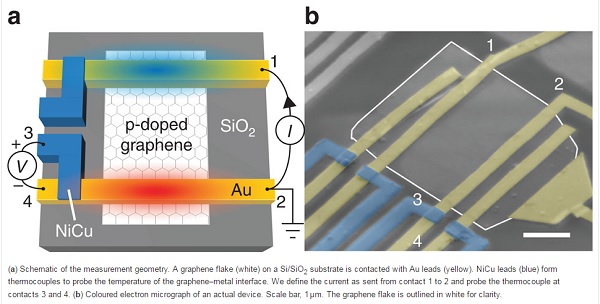Cooling graphene with electrons
Transistors are shrinking, but the heat they produce is becoming a problem. One solution could be to cool them with electrons, relying on what is known as the Peltier effect. This works for beer, and Ivan Vera Marun, a physicist at the Universities of Groningen and Manchester, has now shown that it also works on two-dimensional graphene sheets. The work was published in Nature Communications on 10 May.

Vera Marun set out to investigate the thermoelectric properties of graphene, the two-dimensional form of carbon, in the lab of Bart van Wees, Professor of Physics of Nanodevices at the University of Groningen. ‘Thermoelectrics describes the interaction between a charge current and a heat current’, Vera Marun explains. One interesting application is to use a temperature difference to generate electricity. But there are other options.
‘A normal heat current will flow from a high to a low temperature’, says Vera Marun. Heat is basically the amount of vibration of the atoms in a material. The material cools as the vibration slows down. An electron current normally dissipates electrical energy, causing heat. ‘This is what we call joule heating. But there is another way to heat a material, which uses the Peltier effect’, explains Vera Marun.
Cooling
The Peltier effect describes how an electron current is able to transport heat. This makes the electrons vibrate rather than the atoms. In fact, the atoms can be colder than the electrons that are carrying the heat. To make it even weirder: if you change the polarity of the current, you change the direction of heat transport, and you create a cooling effect. This is Peltier cooling.

Peltier cooling is well known, and can be observed on every campsite. Small electric coolers rely on it. But to observe the effect in a material like graphene is quite a challenge. ‘Graphene is the best conductor of charge and heat that we know of’, says Vera Marun. It is used to make very small transistors and other electronic components. ‘One thing that limits the miniaturization of circuits is the problem of heat. By putting ever more transistors on the same surface area, you generate ever more heat, which you need to dissipate, or the whole thing will melt.’ Peltier cooling could help solve just that.
Vera Marun and his colleagues set out to show this could be done. They created a device that they could use to measure the temperature on a nanometer scale. They used thermocouples for this, which are basically junctions of two different materials. A temperature difference between the two creates a small voltage.
‘We measured the Peltier effect in our device, and showed that we can switch between heating and cooling’, says Vera Marun. They are the first to do so in graphene. ‘This can now be applied to other two-dimensional materials. We will also be looking at how we can exploit such devices.’ The results are described in a paper which was published by Nature Communications on 10 May.
Nobel laureates
Vera Marun worked on this paper at the University of Groningen, but moved to the University of Manchester last year, where he is now a lecturer in Condensed Matter Physics in the department of the Nobel laureates Andre Geim and Konstantin Novoselov who discovered graphene.
Vera Marun’s journey to this lab began at secondary school in Venezuela. His passion for physics was kindled when he participated in several Physics Olympiads. ‘I even made it onto the national team and participated in the Ibero-American Physics Olympiad .’ He later assisted other teams, as a student at Universidad Simón Bolívar . ‘I started out studying electrical engineering, but began to move into physics. I really like both.’ So it is no wonder Vera Marun used fundamental physics to create a device that may one day cool nanoscale electronics.
Reference: I.J. Vera-Marun, J.J. van den Berg, F.K. Dejene & B.J. van Wees: Direct electronic measurement of Peltier cooling and heating in graphene. Nature Communications 7, 10 mei 2016, doi:10.1038/ncomms11525
See also the FOM press release.

| Last modified: | 31 March 2020 10.09 a.m. |
More news
-
16 April 2024
UG signs Barcelona Declaration on Open Research Information
In a significant stride toward advancing responsible research assessment and open science, the University of Groningen has officially signed the Barcelona Declaration on Open Research Information.
-
02 April 2024
Flying on wood dust
Every two weeks, UG Makers puts the spotlight on a researcher who has created something tangible, ranging from homemade measuring equipment for academic research to small or larger products that can change our daily lives. That is how UG...
-
18 March 2024
VentureLab North helps researchers to develop succesful startups
It has happened to many researchers. While working, you suddenly ask yourself: would this not be incredibly useful for people outside of my own research discipline? There are many ways to share the results of your research. For example, think of a...

